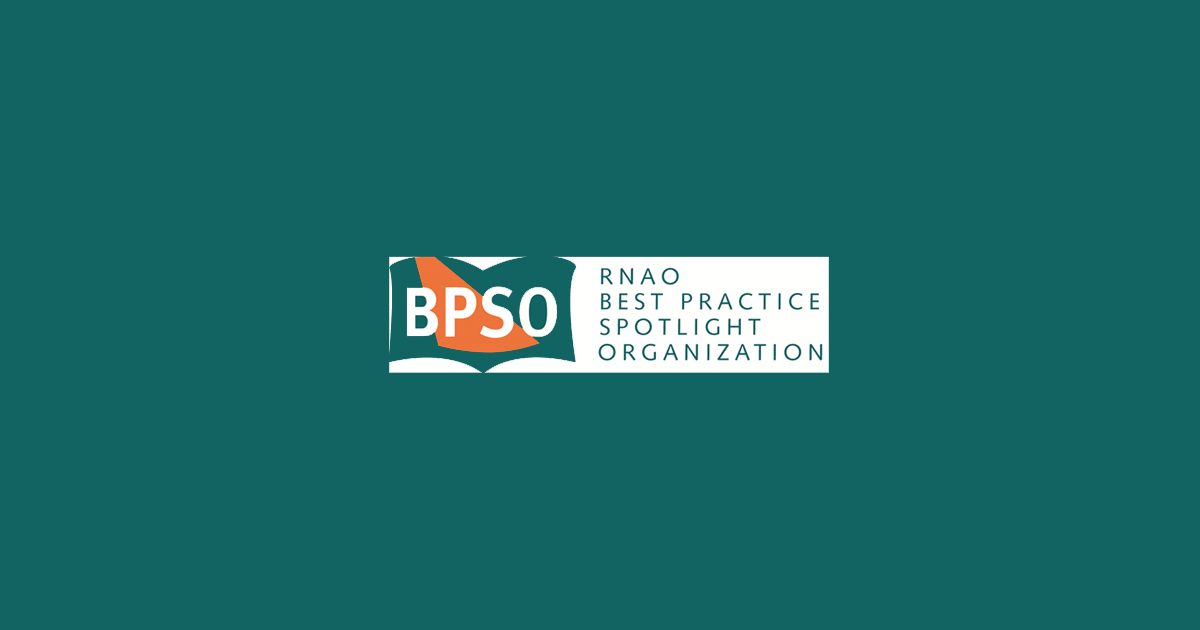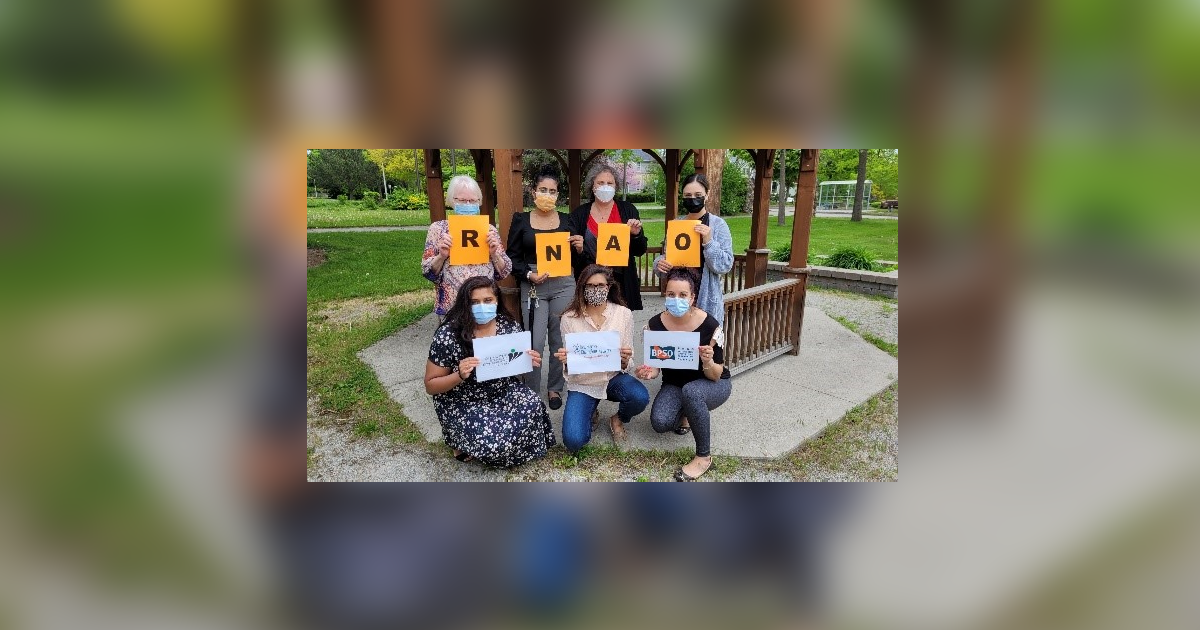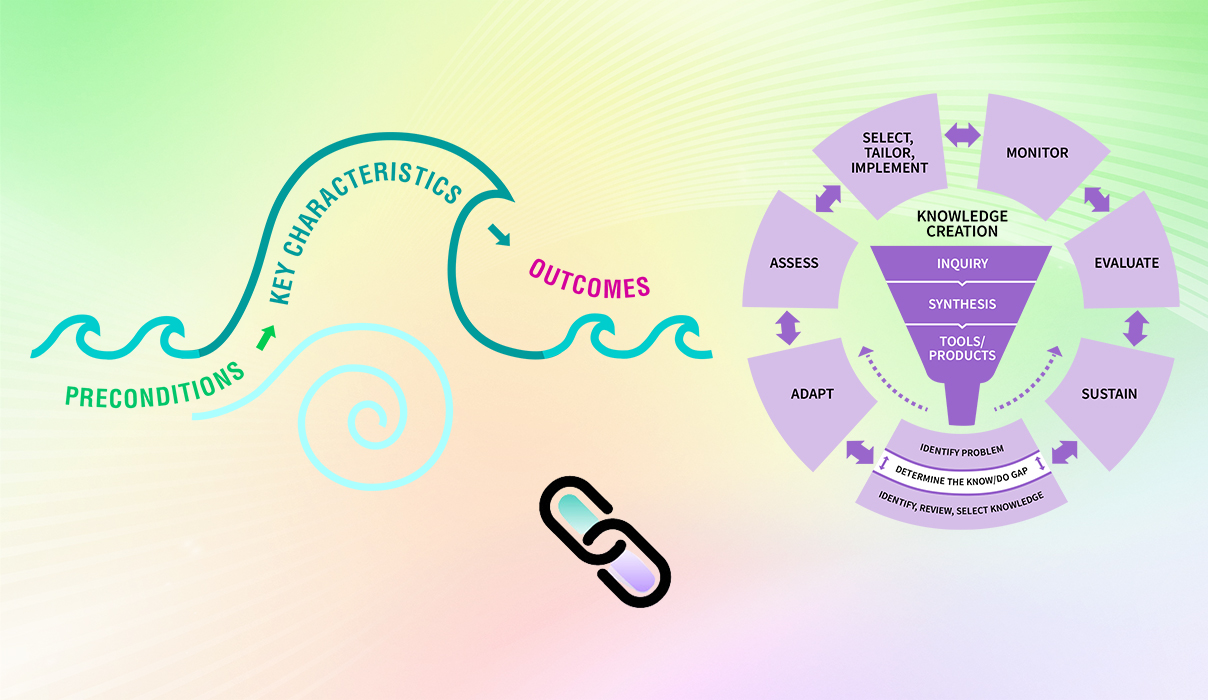Core leadership structures
Index
As a social movement in the context of evidence uptake and sustainability establishes and evolves, a core leadership structure is needed to guide the change initiative and provide strategic direction. A core leadership structure may have many names such as a change team, a steering committee, or an implementation team.
In this section, you will learn the diverse skill set required for members of the core leadership structure to be able to work together as a team and also engage colleagues and others in the change initiative.

What is this element?
A core leadership structure includes formal and informal leaders who work internally (as an inward-facing team) and as an outward-facing team to guide the evolution of a social movement. Leadership is not vested in one person, but across a group of people.
Whether the individuals in the core leadership structure are the initial supporters of the shared concern or desired change –initiators or early adopters – or engage in the change later, all must bring a high level of commitment and energy (Bibby et al., 2009; Blueprints for Change, undated; del Castillo et al., 2016).
Activities include:
- planning and visioning
- building a base of supporters to achieve a critical mass
- defining priority areas and values
- positioning issues
- strategizing for mobilized individual and collective action
- coordinating resources
- supporting the development of a collective identity
- building momentum
- sustaining the cause (Bate et al., 2004a; Bibby et al., 2009; Blueprints for Change, undated; del Castillo et al., 2016).
Working as an outward-facing team is also critical to engage staff’s active involvement and investment in the change. The core leadership team cannot ”own” the initiative, but must be flexible, responsive and open to the input and energy of others to gain momentum and evolve into a critical mass of supporters (Blueprint for Change, undated).
Core leadership structures
Shared or distributed leadership
Leadership is described as shared, distributed, or horizontal with no team member holding more power and control than others.
The leadership structure is not hierarchical and does not apply a top-down “command and control” approach.
Each team member has roles and responsibilities and is accountable to their team members.
Decision-making is shared and equitable amongst the team members.
In cases where the core team determines their structures, roles and responsibilities, they may be self-governed and autonomous.
A mix of content and context experts
Content experts are those who understand change processes and the implementation of evidence uptake and sustainability. They can also be those with subject matter expertise in a clinical and/or work environment area.
Context experts are those who understand the local context – the dynamics and the meaning of the shared concern or strongly desired change in the given setting. They have lived experience of the shared concern and strongly support it as credible and valued.
Some people on the change team might be both content experts and context experts.
To create committed ownership, both types of experts must value one another’s knowledge and contributions to the team.
Organizational support
An effective core leadership structure is to be flexible. It engages the support of others, including formal leaders and peer champions.
Formal leaders – for example, managers or directors of care – can be instrumental in moving a change forward For example, they are needed to approve budgets, and might also be needed to approve collective action activities).
Peer champions (or change agents) are influential leaders who advance and translate the messages and goals of the core structure to their peers.
Variable roles and functions
Core leadership structures are variable and can include change teams, community coalitions, or social movement organizations (SMOs).
A core leadership structure typically has members from one setting and includes both informal and formal leaders whose roles are focused on guiding evidence-informed practice change.
Community coalitions include a group of diverse individuals who represent community services, such as health care, education, or policy. Their combined efforts are targeted at mobilizing for change.
SMOs function in cases of larger social movements where there are regional chapters or groups and a need for a centralized organization to support and guide the broad goals of the social movement.
SOURCES: Bibby et al., 2009; Blueprints for Change, undated; Carson-Stevens et al., 2013; del Castillo et al., 2016; Dementia Action Alliance, 2009; Grinspun and Bajnok, 2018; Klaus & Saunders, 2016.
“If a movement is to have impact it must belong to those who join it, not just those who lead it.” (Simon Sinek, 2017)
Why is this element important?
Social movements require energy, planning and strategy. A core leadership structure is central to the social movement’s formation, advancement and maintenance. It ensures the coordination and organization of activities, the availability of time and resources, and the knowledge and experience in social movement thinking and actions (Bate et al., 2004a; Serna-Restrepo et al., 2018).
A key role of the core leadership structure is to build and support a group of individuals who share its leadership. Without leadership, the social movement will not continue. The team must also continue to invest and train new leaders to make sure that the leadership is replenished and maintained (Carson-Stevens et al., 2013; Grinspun et al., 2018b; Tremblay et al., 2018).
Case studies

Guiding best practice guidelines (BPG) implementation with BPSO implementation teams
To support the effective implementation of BPGs, Best Practice Spotlight Organizations® (BPSOs®) create change teams that operate as core leadership structures to support evidence uptake and sustainability. Their roles in the core leadership structure can include:
- selecting recommendations
- developing an action plan
- mobilizing implementation strategies
- supporting adherence to a practice change
- engaging in monitoring and evaluation activities
- taking active steps to support sustainability
As champions, one role of BPSOs is to compare their current practice to the guideline recommendations to see how the current practice can be maintained, strengthened or changed. Taking a “can do” attitude, they actively collaborate with their peers throughout the change process, and value and welcome their input and ideas. They take on leadership roles to support evidence-based practice change in collaboration with nurses, other staff and others (Bajnok et al., 2018a).

Engaging an interprofessional change team to lead implementation: West Park Healthcare Centre
West Park Healthcare Centre, an RNAO BPSO, is a rehabilitation and complex care centre in Toronto, Canada. They applied a compelling call to action to implement these RNAO BPGs: Assessment and Management of Pain, Client Centred Care and Prevention of Falls and Fall Injuries in the Older Adult.
With support from senior leadership, interprofessional change teams – including nurse leaders, such as advanced practice nurses and nurse practitioners – were responsible for leading the implementation strategies, which included taking collective action. Implementation efforts focused on engaging in quality improvement measures, promoting the culture and values of evidence-based practice and aligning their implementation efforts to the organization’s culture and values.
As members of the implementation teams, the nurse leaders were influencers who aimed to build collaborative and committed relationships amongst the interprofessional team and create a work environment that empowered staff to take evidence-based action. The team embraced diverse perspectives and knowledge to allow for adaptations to the local context.

Engaging collective strength in action at Central West Specialized Developmental Services
Central West Specialized Developmental Services (CWSDS) is a pre-designate Best Practice Spotlight Organization® (BPSO®.) During the BPSO pre-designation process, the CWSDS change team has built a strong core leadership structure to support the implementation of best practices, by including both formal and informal leaders.
The CWSDS change team relied on the following strategies to build a strong core leadership structure:
CWSDS’s RNAO-BPSO organizational structure. Figure provided with permission by CWSDS.
- embedding the RNAO BPSO pre-designation process within the organization’s strategic plan.
- emphasizing the interprofessional nature of the initiative by encouraging professionals from all disciplines to become involved.
- engaging an interprofessional team of stakeholders within the organization with the change, including direct support professionals, managers, food services, human resources staff, and members of the communication and information technology teams.
- encouraging stakeholders to become trained RNAO Best Practice Champions and to participate in RNAO events.
- making sure all stakeholders were informed and involved in the change initiative (by, for example, providing updates during managerial meetings and including stakeholders in completing gap analyses.)
- supporting Best Practice Champions in leading best practice guideline (BPG) implementation alongside the BPSO Steering Committee.
As a result of the change team’s work to build a core leadership structure, they were able to tailor the implementation of BPGs toward daily clinical problems relevant to their direct support professionals. This increased recognition of and support for their change initiative.
To learn more about CWSDS’s BPG implementation journey, watch their 38-minute webinar: Collective Strength in Action: How to Promote and Implement Best Practice Guidelines.
Considerations for getting started
We outline core leadership strategies to reflect the structure’s functions as both an inward- and outward-facing team.
- building the core leadership structure,
- sharing leadership effectively,
- learning to work together,
- engaging staff and others in the change initiative, and
- managing risk and building trust.
Building the core leadership structure
Sharing leadership effectively
Learning to work together
Engaging staff and others in the change initiative
Managing risk and building trust
SOURCES: Bate et al., 2004a; Blueprints for Change, undated; Carson-Stevens et al., 2013; del Castillo et al., 2016; Galford & Drapeau, 2003; Grinspun & Bajnok, 2018; Klaus & Saunders, 2016; Sustainable Improvement Team & the Horizons Team, 2018; Wynn et al., 2011.
Accelerate Your Success: The Knowledge-to-Action Framework’s “Identify the problem” action cycle phase includes strategies for how change teams, as core leadership structures, can work together effectively. As change processes can be complex requiring diverse knowledge and skills, members of change teams must become efficient at working together to be able to reach their goals.
Navigating common problems
Here are some common problems you and your core leadership structure may experience and some suggested strategies to address the problems:
There is a need to replace members of the core leadership structure.
- Strive to find individuals who deeply support the shared concern or strongly desired change
- Be mindful of the diverse skill set needed to lead change and seek out individuals with those abilities
- Recognize that significant time and commitment must be invested to build an effective core leadership structure
- Continue to recruit and mentor new members of the team periodically.
One or more individuals seek to dominate leadership, expecting others to comply with their ideas.
- Remind the group that the strength of the core leadership structure is in its shared leadership model that includes decision-making.
- Should one person continue to dominate, consider using democratic voting processes such as dot voting (see Framing through storytelling | RNAO.ca for more details and resources).
- Seek agreement at meetings regarding agenda items and priority areas.
- Apply processes such as roundtable discussions to facilitate meaningful dialogue and decision-making.
A member of the core leadership structure does not attend team meetings regularly.
- Strive to establish meeting times that work for all members’ calendars, and reinforce the importance of all team members’ presence at meetings.
- Establish a culture of accountability within the team, including clear expectations about following up and reporting back on agenda items.
- Repeat and reinforce positive examples of the team’s strength and effectiveness through collaboration.
- Determine whether all of the team members remain committed to the shared concern or whether they have the available time needed to engage in the core leadership structure. Be aware that interest in participating in the core leadership structure may also change as the social movement evolves and priorities shift.
- Agree as a team on how many meetings a member can miss before being asked to leave the core leadership structure.
The change team has not been able to actively engage others outside of the core leadership structure to co-design the change
- Remain vigilant to engage others in relevant aspects of the change initiative, including individual and collective action activities.
- Ensure regular updates from the core leadership team at staff meetings or huddles, and via communication forums such as group emails.
- Be aware of the limited power of the core leadership structure to achieve and sustain change without the active engagement of others.
Micromanaging has put limits on the role and energy of those not in the core leadership structure.
- Remain flexible and committed to making changes, as needed, to plans and actions based on feedback from others.
- Be aware of and embrace the collective power and energy of others as a vital force for change.
- Avoid at all costs alienating others and ignoring their ideas, energy and feedback.
- Recognize that placing limits on engagement in change by those outside of the core leadership structure can lead to a social movement in name only that will likely fail.
SOURCES: Blueprints for Change, undated; Dementia Action Alliance, 2009.
Check your progress
- You have sought and found opportunities for team members to grow and develop their abilities as leaders.
- You have developed capacity in framing, and are able to position the issues in ways that resonate with people’s emotions and values.
- You have learned to think strategically and creatively in your approaches to change.
- You have supported the development of others as leaders to sustain the social movement and core leadership team.
- You have inspired others to get involved and commit to the change.
- You have organized and brought together the needed resources.
- You have achieved goals fully or partially.
SOURCES: Bibby et al., 2009; Blueprints for Change, undated; del Castillo et al., 2016; Ganz, 2018; Grinspun & Bajnok, 2018; Serna-Restrepo et al., 2018; Klaus & Saunders, 2016.
Accelerate Your Success: The Knowledge-to-Action Framework’s “Sustain Knowledge Use” action cycle phase includes strategies for change teams – as core leadership structures – to support the sustainability of a practice change.
Achieving sustainability requires planning by change teams. Failure to sustain change can limit the positive impacts of the practice change to people or patients and their families, providers, organizations and/or health system.
Determining your progress and impact
Core leadership structures may want to determine their progress and impact as a team. While there are no formalized performance indicators in social movements, the following quantitative and qualitative measures may be helpful:
Quantitative measures
- The number of staff who engaged in the change.
- The number of staff who joined the core team, if applicable.
- The number of communications released to staff.
- The number of staff emails responded to by core team members.
Qualitative measures
- The achievements of the change initiative.
- The impact of the change on the shared concern or strongly desired change.
- The development of capacity in social movement thinking.
- The effectiveness of using social movement thinking as a people-led approach to change.
SOURCE: Blueprints for Change, undated.
Implementation tools
For strategies on how to select a lead and co-lead for a core leadership, download our resource sheet.
Linking this key characteristic to other framework components

Linking this key characteristic to other elements of the Social Movement Action Framework:
Each of the elements of the Social Movement Action (SMA) Framework is dynamic and interrelated. For example, the core leadership structure brings together a group of committed team members to co-design the social movement with the active engagement of change agents, champions and others. The core team, as individuals and collectively, widely promotes and disseminates the shared concern or strongly desired change and the urgent need for action. Their roles include:
- framing or positioning the issue
- relationship building
- engaging others through intrinsic motivation
- supporting emerging leaders actively.
Linking this key characteristic to the action cycle phases of the Knowledge-to-Action Framework:
You and your core leadership structure’s capacity in social movement actions may be enhanced or accelerated by the addition of some of the action cycle phases of the Knowledge-to-Action (KTA) Framework, as the two frameworks are complementary. In addition to the two linking examples described earlier in this section, there can be many other points of connection between the two frameworks. Below are two more examples for your consideration:
- Adapt knowledge to local context: Core leadership structures function in part as ways of securing and deploying resources. Assessing the local context, individuals and/or groups can help you make sure that you and your change team have sufficient resources to execute your plans for the social movement.
- Sustain knowledge use: To sustain change, leaders must commit to building networks and capacity in new leaders. The KTA action cycle phase on sustaining knowledge use can help you and your change team continue the core leadership structures of your social movement and give you guidance on how to enhance emerging leaders.
For more discussion about the dynamic links between the elements of the SMA Framework to one another and to the KTA Framework, see the section "Two complementary frameworks".
More resources
Want to learn more about using the strategies of the SMA and KTA frameworks to support your change? Sign up for the RNAO Best Practice Champions training course.



